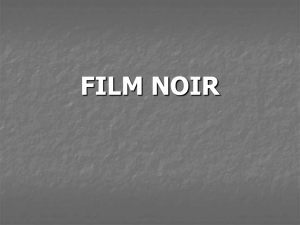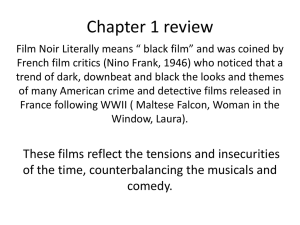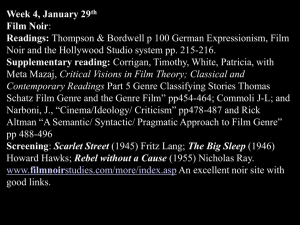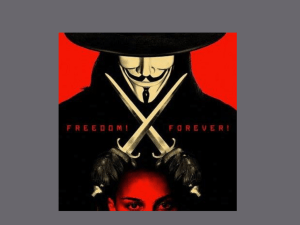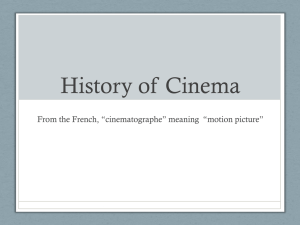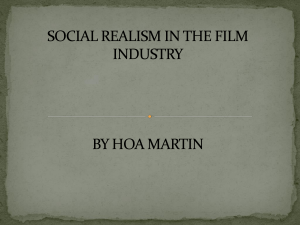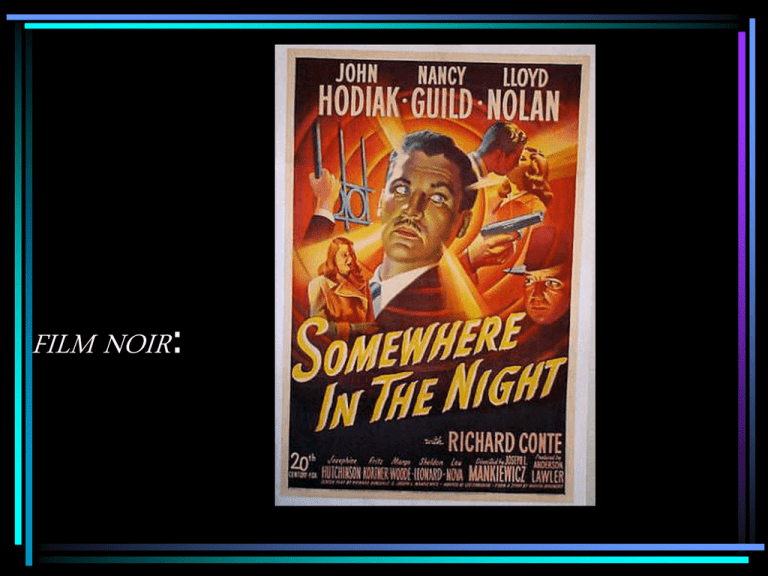
FILM NOIR:
Article by
John
Belton
Presentation
by
Evan Mays
Outline
•
•
•
•
•
•
•
•
•
beginning
noir: genre, series, mode
noir: red guts
noir: stylistics
the Code!
lit. origins
women in film noir
a critique
& revival
Film Noir (1941-1958): Black film.
• Uniquely American term; coined by 2 French film
critics. Noir’s roots are pulp fiction & the wartime
& postwar despair ‘n’ alienation
that arose as America adjusted
to a new social & political reality.
Unsettled audiences by violation
of traditional narrative & stylistic
practices which orient & stabilize
spectators. Dominated by crime,
corruption, cruelty & a seemingly
unhealthy interest in the erotic.
Film Noir as Genre
• Genre: (from the French)
kind, type or category of
phenomenon or particular
thing; in cinema used to
designate various categories
of motion picture production.
• A # of recent scholars
approach noir thus, discussing
it in terms of iconography,
fixed character types &
predictable narrative patterns.
Film Noir as Series
• Certain characters, narrative
situations, & thematic concerns
appear repeatedly in noir, but
these elements play against
audience expectations; also,
noir crosses over traditional
genre boundaries. Because of
this some critics see film noir
as a series or “cycle”, like an
aesthetic movement.
Film Noir as Series
• Producers, directors &
screenwriters of ’40s
& ’50s noirs, unlike
genre filmmakers, do
not deliberately set out
to make noir as no
body of set convention
exists to follow.
• The audiences who see films noirs do not view
them as they do conventional genre pictures.
That is, they do not look at them in relation to
a fixed system of prior expectations.
Film Noir as Series
• Noirs rely upon identifiable
character types &
conventionalized narrative
patterns. But that which is
generic in film noir is
that which is not “noir”.
• A schizophrenic nature:
noir is not a genre, yet
every film noir is also a genre film. What makes
these films “noir” is the similar, transgeneric
attitude they take towards any particular genre.
Film Noir as Mode
• Noir as specific emotional reaction
produced by certain films: noir as
affective phenomena. “Noir” for a
moment is film noir.
• “Noir” as a description of tone,
attitude, mood—not so much a
genre as a mode—a particular
way in which genre information
is conveyed.
• However, traditional modes do
have temporal boundaries.
not
Film Noir as All?
• Both a style & a bundle of thematic concerns,
film noir initially seems to be a phenomenon
that could appear at any moment in time.
But, as an aesthetic movement, it is
necessarily grounded in a particular historical
period—that of wartime & postwar America.
• Noir is part genre, part series, part mode.
• P.S. It’s all about disturbance in the end…
Red Guts of Film Noir
Aesthetically, noir relies on:
• shadowy, low-key lighting
• deep-focus cinematography
• distorting, wide-angle lenses
• sequence shots
• disorienting mise-en-scene
• tension-inducing, oblique &
vertical compositional lines
• jarring juxtapositions between shots involving
extreme changes in camera angle/screen size
• claustrophobic framing
• romantic, voice-over narration
• a complex narrative structure, characterized
by flashbacks and/or a convoluted temporal
sequencing of events
Thematically, noir grapples w/existential issues of:
• the futility of individual action
• the alienation, loneliness & isolation of the
individual w/in industrialized, mass society
• the problematic choice between
being & nothingness
• the absurdity, meaninglessness
purposelessness of life
• the arbitrariness of social justice, which results
in individual despair, & leads to chaos, violence
& paranoia.
&
Red Guts of Film Noir
• Noir heroes do not need to be detectives. Often,
they are merely antisocial loners. But even the
gainfully employed are subject to a certain
deadpan, existential angst, especially given their
relatively faceless anonymity w/in a larger,
dehumanizing work environment.
“Why do you think some scholars consider the
most existential of all film noir heroes to be the
amnesiac?”
Noir Stylistics: Shadow of the ‘30s
• Narrative linearity of C. H. C. gives
way to narrative disjunction,
fragmentation, & disorientation.
Soft, evenly distributed high-key
lighting yields to harsh, low-key
lighting; obscures the action,
deglamorizes the star, & reduces
actors to shadowy formal elements
embedded within overall design of
the noir’s composition.
Noir Stylistics: Shadow of the ‘30s
• Carefully constructed sense of space
disappears; replaced by wide-angle
cinematography: distorts space,
disorients viewer. Conventional eyelevel camera positions give way to
extreme low-/high-level perspective:
assaults the viewer’s complacency.
• Every violation of “norm” marks an
intrusive intervention between
spectator, exposition: foregrounds
narrative form making it visible.
Noir Stylistics: Shadow of the ‘30s
When the staple of the industry & the film most
frequently identified with everyday motion
picture entertainment, the genre film, developed
psychotic tendencies, audiences of the time new
something was “wrong”; more so, they “felt” it.
Noir and the Production Code
• American films of mid- to late ‘30s rarely dealt
with taboo subjects. Noir frequently does,
resulting in amazing displays of narrative
contortions in order to allude to prohibited
material w/out directly violating the Code!
• Violence takes place off screen; its intensity
amplified by disjunctive edits &/or sound effects.
• Homosexuality prominent plot motive for a # of
novels turned noirs; onscreen, motive displaced,
desexualized—lays bare deep cultural fears of it.
Noir and the Production Code
Relaxation of Code in late 1950s & advent of
ratings system in late 1960s paves way for a
new era of explicitness in 1970s.
Subject matter sensational, presentation
neither disturbed nor disturbing; as
classically “direct” as any of Hollywood’s
1930s films.
Ease w/which once taboo material dealt w/in
“liberated” climate of ’70s distinguishes
“authentic” film noirs of the ’40s & ’50s from
pseudo-noirs of the 1970s & onwards.
Noir and the Production Code
Remember !!! The Production Code played a
crucial role in creating noir. Subsequent
changes in this Code result in the production
of films that are decidedly less noir.
Literary origins of Film Noir
In postwar era mistaken belief arises
that simple world of prewar America
could be recreated. Realization that
this was a delusion influences worldweary cynicism of film noir, & the
sense of frustration & experience of
disempowerment at its center.
America’s innocence was lost. Noir
suggests it was lost long before war,
that it was more than $, jobs that
were lost during Great Depression.
Noir’s Literary Origins
• Unlike English detective fiction,
features proletarian tough guy
living on fringe of criminal world.
Relies only upon animal cunning,
dogged perseverance, physical stamina
& brute force to solve his cases.
• Noir heroes, detective or not, are
weak intellects. They attempt to
make up for this failing with verbal
wit. The writer of detective fiction
& the detective hero both control their
worlds by controlling language.
Literary origins of Film Noir
• Content & style of American hard-boiled novels
introduced new tradition of realism to genre of
detective novel. Characterized by shift in:
detective’s class & technique, milieu, language.
• Contemporary America an urban, industrialized
landscape of those bound to naturalistic drives.
• “Boys in the back room,” as Edmund Wilson
called “Black Mask” school of writers of pulp
detective fiction, inspired by Émile Zola, &
other 19th Century naturalists’ matter-of-fact
depiction of decadence & corruption.
Women in Film Noir
All weakness is associated with the feminine.
•
Women in Film Noir
• Women & the feminine: a threat
on two fronts—socioeconomic &
psychoanalytic.
• Socioeconomic (1): changing
status of American women
during war/postwar period
challenges patriarchy; entry into
workforce & takeover of trad.
male roles further violates
fundamental order of sexual
relations.
Women in Film Noir
• Changes threaten traditional values
centered in the institution of family.
• Noir registers this anti-feminist
backlash by providing pictures of a
postwar America where there is no
family or where family exists
chiefly as a (-) phenomenon characterized as a
claustrophobic, emasculating trap or a bankrupt
system of perfunctory relationships, featuring
murderous wives & corrupt children.
Women in Film Noir
• Leaving the private sphere (home &
family) to enter the public sphere of
work, women, it is assumed, have
abandoned the domestic needs of
sweethearts, husbands, & children.
• Noir dramatizes the consequences of
this neglect, transforming women
into willful creatures intent on
destroying both their mates & the
sacred institutions of the family.
Women in Film Noir
• C. H. C. was at great pains to shield the “family”
from the world of crime. Traditional genre films
routinely oppose the sacred
space of the “family” to that
of the world outside.
• In noir, the world of crime &
that of the family overlap.
Crime’s moved from outside
the family to within, & the
impetus for crime comes as
often from women as men.
• Psychoanalytic
(2): the image of
women on-screen
functions to recall,
for the male
spectator, the
castration anxiety
he experiences
on first perceiving
sexual difference as
a child (Mulvey).
Women in Film Noir
• C. H. C. supports male
dominance & its attempts
to alleviate castration
anxiety by disavowal:
the female’s “castrated”
status is denied.
• This disavowal achieved
by fetishization and/or
devaluation of female; a
way to erase her threat.
Women in Film Noir
• Fetishization: image of
women is overvalued
thru use of techniques
that transform her into
spectacle; lack which
she signifies is in this
way “filled in,” replaced
by her objectification.
• Devaluation: women seen as guilty object—her
“castration” is a symbol of her punishment.
A Critique of Populism
• Destabilization of sex. relationships in
noir symptom of larger social disorder.
• Prior to WW II, American society held together by
various myths that structured a national identity &
rested upon principles of Jeffersonian democracy.
• “Democratic” promise of cheap or free land
motivation for western settlement, which became
a realization of America’s ‘manifest destiny’.
A Critique of Populism
• Closing frontier, exhaustion of free land, & rapid
industrialization of America in latter 19th Century
begins slow process of social change.
• By 1920, for first time in American history, more
people in urban than rural areas. Millions of
laborers & white-collar workers live new reality
but subscribe to old, preindustrial-era myths.
• Only after Depression do myths begin to waiver.
A Critique of Populism
• Film noir reflects transitional stage in American
ideology as American identity shifts from 19th
Century, preindustrial, agrarian prototypes to 20th
Century models, which acknowledge the nation’s
transformation to a mass, consumer society: the
industrialized corporate state.
• As a movement, noir reflects a chaotic period
where old myths begin to crumble & no new
myths exist to take their place—the period in
which national identity is in a crisis.
A Critique of Capra—
A Critique of Populism
• Example of old myths in Capra; films epitomize
classicism, order of pre-noir ‘wood cinema, &
celebrate 19th Century agrarianism. Stalwart
protagonists fight the 20th Century evils that
threaten populist spirit of small-town America.
• Nightmare inversion of Capra’s ideal American
community in It’s a Wonderful Life illustrates
noir’s subversive relationship to C. H. C. which
attempts to repress the very forces to which noir
gives voice. However, turns out “It was just a
dream. . .”
Film Noir: the Undercurrent ends
• Noir does not dismantle American myth or identity
in the ‘40s; proves only one current in flood of
films reaffirming traditional values. By the late
‘50s, advent of TV virtually destroys low-budget,
B-film industry (provided bulk of noirs). New
mood reflects postwar prosperity at decade’s end
& Americans turn from depressed thoughts of
technological blight to utopian visions of machineage paradises, filled w/labor-saving devices.
• Film noirs cease to speak to the needs some feel
for films that address their existential malaise.
Vietnam, etc.: Noirs Revisited
• Trauma of Depression & shell-shock of war
years has been treated, cured. Supposedly.
• However, in the ‘70s Americans rediscover
noir of the ‘40s & ‘50s; becomes the source
material that prompts new understanding
of postwar American reality.
• In rediscovering it Americans locate a more
modern body of myths thru which they might
come to terms with contemporary American
experience.
End
(remember)
• Film noir emerges
as a cycle or
series of films. It
consists of a
finite group of
motion pictures
made during a
specific historical
period which
share certain
aesthetic traits &
thematic
concerns.
• By Evan Mays

